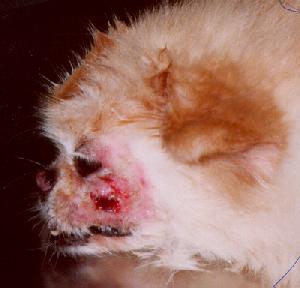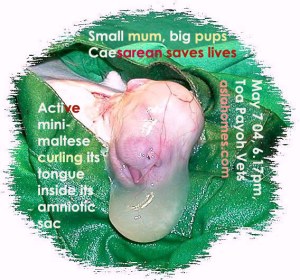So, I spent whatever free time to read this magazine to improve my digital photography. To make better pictures for my veterinary cases so that readers can enjoy and be educated at www.toapayohvets.com.
You can see my bad pictures in 1997 when I started digital photography and used a cheap camera. A bad workman quarrels with his tools. Well, it was my lack of knowledge of digital photography rather than the Fuji digital camera I bought.
 Oro-nasal fistula in 1997. Oro-nasal fistula in 1997.
One of my first product of digital photography. |
A phone call from
Australia from a 3rd year vet undergraduate from
Murdoch University
vibrated on my handphone. "My friend's Pomeranian has
twitching back legs," he asked me to walk out of the 8th floor
library to answer the phone. I was already walking out.
My instant diagnosis was distemper as I had two cases recently.
But the young man had said, "I asked my friend whether the Pom
had fallen down and injured her hind legs? My friend said that
the Pom did not fall down or injure herself. Both legs are
twitching. Could it be hypocalcaemia?" the young man asked when
he told me that the Pomeranian had given birth."
"Yes, you are spot on," I am glad that this young man had
figured out the correct diagnosis.
 This
was a walk in the park for vets who work with breeders as I did
some 3 years ago where I cornered 80% of the Singapore dog
breeder's business and worked past midnight to attend to
emergency Caesarean sections at $250 per Caesarean section at
any time and any day including public holidays. The fees would
be around $1,000 in private practice.
This
was a walk in the park for vets who work with breeders as I did
some 3 years ago where I cornered 80% of the Singapore dog
breeder's business and worked past midnight to attend to
emergency Caesarean sections at $250 per Caesarean section at
any time and any day including public holidays. The fees would
be around $1,000 in private practice.
It was a very tiring period. It involved all sorts of nonsense
of false alarms when the breeder's dog decided to give birth
while I waited with the ghosts at my Surgery in the silence of
the tropical hours past midnight. I did not get paid for waiting
should the breeder cancel the appointment. Non-payment for
Caesarean section by some breeders was common. One tried to
lower my fees saying another vet charged only $200 for a
Caesarean section. This $250 fee for a Caesarean section was a
losing business model, unsustainable in the long run even if
there were large volumes.
However, I gained considerable experiences in anaesthesia and
surgery in the 3 years. Some interesting cases I had documented
for my continuing education and review to improve my skills and
share with vets over the internet are at:
Dr Sing's Caesarean sections
It was quite a relief that the breeders decided to ditch me for
another vet who would satisfy their demands. Now, I have more
time to enjoy and talk to my private patients rather than being
absent somewhere in the breeding kennels.
"Normally
milk fever occurs when puppies are around 6 weeks old.
They drink a lot of milk." I said.
"But the puppies are 4 weeks old," he said.
"Milk fever may occur from 4 weeks onwards," I replied. "The
puppies are big and fat from drinking excessively. How come the
puppies have not been weaned? How is the mother now? Is she
eating?"
"The dam is OK. Running around but very reluctant to let the
puppies suckle."
The puppies already have sharp teeth and it is painful to the
poor mum. But I did not have time to say that.
"Must my friend bring the dog to the vet? What is the
treatment?"
"If the dam is still running around and eating, there is no need
to go to the vet to get the calcium injection IV from the vet."
I said.
"What should she do?"
"Give the dog milk and good food. Bottle feed the puppies," I
said. "Otherwise the dam will have tetanic fits and will die if
she does not get the IV calcium injection."
"What type of milk to give to the dam? The puppy milk?"
"Cow's milk if the dam is tolerant to lactose in the milk. If
the dam has good food and has stopped nursing, she will be OK."
This is the trouble with a rushed telephone consultation when I
don't see the patient and need to save some money on long
distance calls. Why should the 4-week-old puppies be bottle-fed?
I mean, they ought to be weaned and eating puppy food!
In conclusion, for the benefit of home breeders, the dam is
having the start of a milk fever or hypocalcaemia. Stop her from
giving the puppies milk immediately. Give her good food. She
should recover fully.
 P.S.
I made another phone call to the young man after recording the
above article to see whether he could take some pictures of the
pups. "The pups were only 2 weeks old and the dam had given
birth many times," the young man said. He had not seen the pups
or the dam when he phoned me. "Is the dam very thin?" I asked.
"It is a small-sized Pom," he said.
P.S.
I made another phone call to the young man after recording the
above article to see whether he could take some pictures of the
pups. "The pups were only 2 weeks old and the dam had given
birth many times," the young man said. He had not seen the pups
or the dam when he phoned me. "Is the dam very thin?" I asked.
"It is a small-sized Pom," he said.
Milk fever can occur when the pups are 2 weeks old and when the
dam is not in top condition as apparent in this case. This case
illustrates the difficulty of getting the history correctly over
a telephone diagnosis. The diagnosis is still correct. In this
situation, the pups must be bottle-fed and the dam will recover
well. Continuing will mean that the dam will pant and be unable
to stand up, leading to death unless she is treated promptly for
hypocalcaemia by the vet.
 TOA
PAYOH VETS
TOA
PAYOH VETS